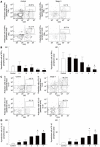Immunological milieu in the peritoneal cavity at laparotomy for gastric cancer
- PMID: 22509078
- PMCID: PMC3319942
- DOI: 10.3748/wjg.v18.i13.1470
Immunological milieu in the peritoneal cavity at laparotomy for gastric cancer
Abstract
Aim: To investigate the immunological repertoire in the peritoneal cavity of gastric cancer patients.
Methods: The peritoneal cavity is a compartment in which immunological host-tumor interactions can occur. However, the role of lymphocytes in the peritoneal cavity of gastric cancer patients is unclear. We observed 64 patients who underwent gastrectomy for gastric cancer and 11 patients who underwent laparoscopic cholecystectomy for gallstones and acted as controls. Lymphocytes isolated from both peripheral blood and peritoneal lavage were analyzed for surface markers of lymphocytes and their cytokine production by flow cytometry. CD4(+)CD25(high) T cells isolated from the patient's peripheral blood were co-cultivated for 4 d with the intra-peritoneal lymphocytes, and a cytokine assay was performed.
Results: At gastrectomy, CCR7(-) CD45RA(-) CD8(+) effector memory T cells were observed in the peritoneal cavity. The frequency of CD4(+) CD25 (high) T cells in both the peripheral blood and peritoneal cavity was elevated in patients at advanced stage [control vs stage IV in the peripheral blood: 6.89 (3.39-10.4) vs 15.34 (11.37-19.31), P < 0.05, control vs stage IV in the peritoneal cavity: 8.65 (5.28-12.0) vs 19.56 (14.81-24.32), P < 0.05]. On the other hand, the suppression was restored with CD4(+) CD25(high) T cells from their own peripheral blood. This study is the first to analyze lymphocyte and cytokine production in the peritoneal cavity in patients with gastric cancer. Immune regulation at advanced stage is reversible at the point of gastrectomy.
Conclusion: The immunological milieu in the peritoneal cavity of patients with advanced gastric cancer elicited a Th2 response even at gastrectomy, but this response was reversible.
Keywords: Cytokines; Gastric cancer; Lymphocytes; Peritoneal cavity; Regulatory T cell.
Figures




Similar articles
-
Search for immunomodulatory effects of blood transfusion in gastric cancer patients: flow cytometry of Th1/Th2 cells in peripheral blood.Ann Clin Lab Sci. 2001 Apr;31(2):171-8. Ann Clin Lab Sci. 2001. PMID: 11337907
-
Increased populations of regulatory T cells in peripheral blood and tumor-infiltrating lymphocytes in patients with gastric and esophageal cancers.Clin Cancer Res. 2003 Oct 1;9(12):4404-8. Clin Cancer Res. 2003. PMID: 14555512
-
Activation of human peritoneal immune cells in early stages of gastric and colon cancer.Surgery. 2007 Feb;141(2):212-21. doi: 10.1016/j.surg.2006.06.031. Epub 2006 Sep 27. Surgery. 2007. PMID: 17263978
-
Does the intraoperative peritoneal lavage cytology add prognostic information in patients with potentially curative gastric resection?J Gastrointest Surg. 2006 Feb;10(2):170-6, discussion 176-7. doi: 10.1016/j.gassur.2005.11.001. J Gastrointest Surg. 2006. PMID: 16455447
-
Peritoneal washing cytology in gastric cancer. How, when and who will get a benefit? A review.Minerva Gastroenterol Dietol. 2011 Mar;57(1):43-51. Minerva Gastroenterol Dietol. 2011. PMID: 21372769 Review.
Cited by
-
Oncolytic vaccinia virus reinvigorates peritoneal immunity and cooperates with immune checkpoint inhibitor to suppress peritoneal carcinomatosis in colon cancer.J Immunother Cancer. 2020 Nov;8(2):e000857. doi: 10.1136/jitc-2020-000857. J Immunother Cancer. 2020. PMID: 33199510 Free PMC article.
-
Isolation of lymphocytes from the human gastric mucosa.World J Methodol. 2021 Jul 20;11(4):199-207. doi: 10.5662/wjm.v11.i4.199. eCollection 2021 Jul 20. World J Methodol. 2021. PMID: 34322369 Free PMC article. Review.
-
TLR Agonist Nano Immune Therapy Clears Peritoneal and Systemic Ovarian Cancer.Adv Healthc Mater. 2025 Mar;14(7):e2402966. doi: 10.1002/adhm.202402966. Epub 2024 Oct 31. Adv Healthc Mater. 2025. PMID: 39478634 Free PMC article.
-
Regional Immunotherapy for Peritoneal Carcinomatosis in Gastroesophageal Cancer: Emerging Strategies to Re-Condition a Maladaptive Tumor Environment.Cancers (Basel). 2023 Oct 23;15(20):5107. doi: 10.3390/cancers15205107. Cancers (Basel). 2023. PMID: 37894473 Free PMC article. Review.
-
STING activation normalizes the intraperitoneal vascular-immune microenvironment and suppresses peritoneal carcinomatosis of colon cancer.J Immunother Cancer. 2021 Jun;9(6):e002195. doi: 10.1136/jitc-2020-002195. J Immunother Cancer. 2021. PMID: 34145029 Free PMC article.
References
-
- Huber V, Fais S, Iero M, Lugini L, Canese P, Squarcina P, Zaccheddu A, Colone M, Arancia G, Gentile M, et al. Human colorectal cancer cells induce T-cell death through release of proapoptotic microvesicles: role in immune escape. Gastroenterology. 2005;128:1796–1804. - PubMed
-
- Galon J, Costes A, Sanchez-Cabo F, Kirilovsky A, Mlecnik B, Lagorce-Pagès C, Tosolini M, Camus M, Berger A, Wind P, et al. Type, density, and location of immune cells within human colorectal tumors predict clinical outcome. Science. 2006;313:1960–1964. - PubMed
-
- Tsujimoto H, Ono S, Ichikura T, Matsumoto Y, Yamamoto J, Hase K. Roles of inflammatory cytokines in the progression of gastric cancer: friends or foes? Gastric Cancer. 2010;13:212–221. - PubMed
Publication types
MeSH terms
Substances
LinkOut - more resources
Full Text Sources
Medical
Research Materials

